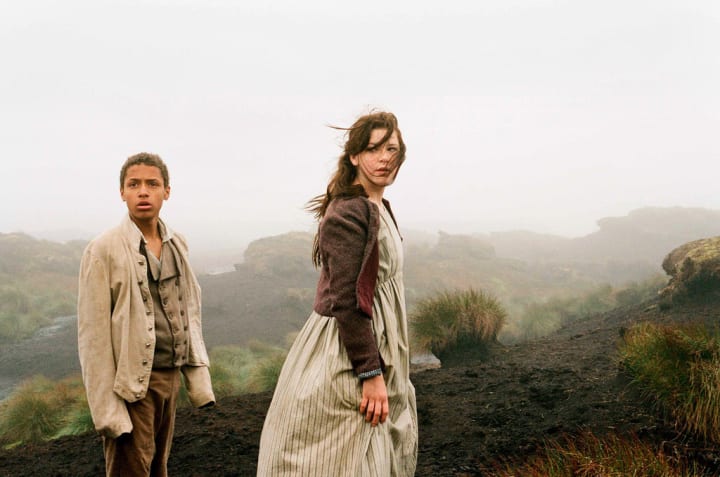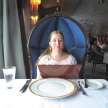Literary Essay #2: 'Wuthering Heights'
Landscape in 'Wuthering Heights'

Emily Brontë and her sisters Charlotte and Anne grew up on the West-Yorkshire moors, a landscape which went on to influence their novels and provide a suitable backdrop for their dark, turbulent tales of wild, uncontrollable passion. The Yorkshire moors are a barren and difficult habitat, where it is hard to survive due to the harsh terrain and bad weather, that possess a stark, dramatic beauty. Emily Brontë was an heir to the Romantic and Gothic traditions which favored ruined old buildings and untamed and uncultivated landscapes as a reflection of the tempestuous emotions of the characters. Her only novel, Wuthering Heights, is a prime example of this.
Wuthering Heights takes place in a remote part of the Yorkshire moors. The titular Wuthering Heights is an isolated farmhouse overlooking the wild and windy moors where the novel’s action takes place. We are introduced to actual Wuthering Heights when bad weather obliges Lockwood, the novel’s narrator, to stay the night there. Lockwood gives a definition of the word “wuthering” and an explanation as to why the house was given that name:
“Wuthering being a significant provincial adjective, descriptive of the atmospheric tumult to which its station is exposed in stormy weather. Pure, bracing ventilation they must have up there at all times, indeed: one may guess the power of the north wind blowing over the edge by the excessive slant of a few stunted firs at the end of the house; and by a range of gaunt thorns all stretching their limbs one way, as if craving alms of the sun.”
(Brontë 4)
The Yorkshire moors are a barren, inhospitable place where only the toughest plants and people can survive. Like with trees which grow near Wuthering Heights, the people who live there are warped and twisted by the harsh climate. The house itself is described as an old and appropriately foreboding building: “Happily, the architect had foresight enough to build it strong: the narrow windows are deeply set in the wall and the corners defended with large jutting stones” (Brontë 4) and the people who live there as no more welcoming than the building they live in. Lockwood’s first impressions of Wuthering Heights and its inmates characterize it as an unpleasant, troubled place which hides dark secrets.
When he stays the night at Wuthering Heights, Lockwood is given a bedroom which once belonged to a woman named Catherine Earnshaw Linton, who was the foster sister and childhood sweetheart of Heathcliff, the house’s current owner. The room is filled with reminders of her life: her name is carved into the wall and notes she wrote are inscribed in the books. Lockwood falls asleep and has a dream where he is haunted by a ghost calling herself Catherine:
“The intense horror of nightmare came over me: I tried to draw back my arm, but the hand clung to it, and a most melancholy voice sobbed, ‘Let me in- let me in!’ ‘Who are you?’ I asked, struggling, meanwhile to disengage myself. ‘Catherine Linton,’ it replied, shivering… ‘I’m come home: I’d lost my way on the moor!’... ‘Twenty years. I’ve been a waif for twenty years.’”
(Brontë 22)
It is ambiguous whether or not Wuthering Heights is literally haunted by Catherine’s ghost but it is certainly haunted by her in a figurative sense.
The first few chapters of Wuthering Heights put together the ingredients necessary for a classic gothic novel: stormy weather, an old building in a dramatic and remote location, a brooding antihero, a heroine who died tragically young, ghosts, and dark secrets. Writers of Emily Brontë’s generation were influenced by the earlier romantic and gothic movements. Both genres favored the highly emotional and dark aspects of human existence and the natural world. A gothic novel is typically set in a dramatic and isolated location and involves an ancient ruin, such as a castle or abbey, which is haunted, both literally and figuratively, by the ghosts of the past. Storms and their human equivalent fits of madness, as well as supernatural elements, are common motifs. The ghosts and turbulent weather are reflections of the turbulent emotions and tragic pasts of the characters.
A lost child wandering the moors and wishing to come home is an appropriate form for Catherine’s ghosts to take. The moors surrounding Wuthering Heights was Catherine and Heathcliff’s childhood playground and is a symbol for their love. This landscape is wild and untamed, like Catherine and Heathcliff as children, and difficult to navigate, like their relationship and emotions. When describing her feeling for Heathcliff in contrast to her feelings for Edgar Linton, her eventual husband, Catherine says: “My love for Linton is like the foliage in the woods: time will change it, I’m well aware, as winter changes the trees. My love for Heathcliff resembles the eternal rocks beneath: a source of little visible delight but necessary.” (Brontë 70). Wuthering Heights is a harsh place to live and hard to love but somehow Catherine and Heathcliff find it impossible to exist anywhere else.
Like the moors, Heathcliff is dark, mysterious, and dangerous. His name, Heathcliff, suggests the Yorkshire landscape: a heath is an open area of uncultivated land on which grows heather and coarse grasses and a cliff is a steep rock face; both geographic features make up the moors. When he is first introduced, Heathcliff is a figure of fear and suspicion because of the fact that he was born a gypsy and his origins are unknown. Distrust of the unknown causes people to despise Heathcliff and be wary of the moors. Part of what makes the moors so dangerous is the unpredictable weather. Storms occur in Wuthering Heights when passions and tensions between the characters are at their highest. The night on which Heathcliff runs away after hearing that Catherine is considering marriage with Edgar is dark and stormy:
“It was a very dark evening for summer: the clouds appeared inclined to thunder...There was a violent wind, as well as thunder, and either one or the other split a tree off at the corner of the building: a huge bough fell across the roof and knocked down a portion of the east chimney-stack, sending a clatter of stones and soot into the kitchen-fire.”
(Brontë 72)
Later on in the novel, a heavily pregnant Catherine runs out into a storm, causing her to become ill and die in childbirth. The attraction between Catherine and Heathcliff is a lot like a storm: an intense, destructive, and unstoppable force of nature which consumes all around it.
The antithesis of Wuthering Heights is Thurshcross Grange. While Wuthering Heights is rough and coarse, Thrushcross Grange is elegant and refined; while Wuthering Heights represents the wild and passionate, Thrushcross Grange represents the tame and placid. Thrushcross Grange is separated from Wuthering Heights and the moors by a large hill. This distance makes Thrushcross Grange both a safe haven and a gilded cage. Cathy, the daughter of Catherine and Edgar, has a happy childhood at Thrushcross Grange, sheltered away from the malevolent influence of Wuthering Heights. But like her mother, Cathy feels an irresistible attraction to the moors and badgers her nursemaid, Ellen, to be able to explore them:
“Sometimes, indeed, while surveying the country from her nursery window, she would observe—
‘Ellen, how long will it be before I can walk to the top of those hills? I wonder what lies on the other side-is it the sea?’
‘No, Miss Cathy,’ I would answer; ‘it is hills again, just like these.’
‘And what are those golden rocks like when you stand under them?’ she once asked.
The abrupt descent of Penistone Crags particularly attracted her notice; especially when the setting sun shone on it and the topmost heights, and the whole extent of landscape besides lay in shadow. I explained that they were bare masses of stone, with hardly enough earth in their clefts to nourish a stunted tree.
‘And why are they bright so long after it is evening here?’ she pursued.
‘Because they are a great deal higher up than we are,’ replied I; ‘you could not climb them, they are too high and steep. In winter the frost is always there before it comes to us; and deep into summer I have found snow under that black hollow on the north-east side!’
‘Oh, you have been on them!’ she cried gleefully. ‘Then I can go, too, when I am a woman. Has papa been, Ellen?’
‘Papa would tell you, Miss,’ I answered, hastily, ‘that they are not worth the trouble of visiting. The moors, where you ramble with him, are much nicer; and Thrushcross Park is the finest place in the world.’
‘But I know the park, and I don’t know those,’ she murmured to herself.”
(Brontë 159-160)
Cathy, with her willful, free-spirited nature, is very much her mother’s daughter. She becomes bored with the restrictions of Thrushcross Grange and longs to escape. Despite its security and tranquil beauty, Thrushcross Grange is a stifling place for people like Catherine and Cathy.
Catherine agrees to marry Edger because she likes the idea of being mistress of Thrushcross Grange and improving her social station but marrying Edgar takes her away from her beloved moors. At her new home, Catherine pines away, changing from a hearty, willful tomboy to a bored, sickly invalid, like an animal taken away from its natural habitat. As she is dying, Catherine reminisces about her childhood and expresses her desire to return to those simpler times:
“Oh, I’m burning! I wish I were out of doors! I wish I were a girl again, half savage and hardy, and free; and laughing at injuries, not maddening under them! Why am I so changed? why does my blood rush into a hell of tumult at a few words? I’m sure I should be myself were I once among the heather on those hills. Open the window again wide: fasten it open!"
(Brontë 105)
Catherine left Heathcliff and Wuthering Heights because she thought she could do better. But leaving them made her realize that she could not live without them. Her ghost haunts the moors she loved in life as the wild child she was in her happier days.
If Wuthering Heights is a cursed building, the only thing that can break the curse is Catherine’s return. In a way, a Catherine returns to Wuthering Heights. Heathcliff tries to get a hold of Thrushcross Grange by using Cathy’s curiosity about Wuthering Heights to lure her there and force her to marry his dying son Linton. After Linton’s death, Cathy falls in love with and marries Hareton, the son of Hindley Earnshaw, Heathcliff’s former enemy, and the rightful owner of Wuthering Heights. The book ends with Heathcliff dying and his soul being reunited with Catherine.
“But the country folks, if you ask them, would swear on the Bible that he walks: there are those who speak to having met him near the church, and on the moor, and even within this house. Idle tales, you’ll say, and so say I. Yet that old man by the kitchen fire affirms he has seen two on ’em looking out of his chamber window on every rainy night since his death: and an odd thing happened to me about a month ago. I was going to the Grange one evening—a dark evening, threatening thunder—and, just at the turn of the Heights, I encountered a little boy with a sheep and two lambs before him; he was crying terribly; and I supposed the lambs were skittish, and would not be guided.
‘What is the matter, my little man?’ I asked.
‘There’s Heathcliff and a woman yonder, under t’ nab,’ he blubbered, ‘un’ I darnut pass ’em.’”
(Brontë 283)
The two are buried on the moors they loved so much and everything appears to have been set right.
“I lingered round them, under that benign sky: watched the moths fluttering among the heath and harebells, listened to the soft wind breathing through the grass, and wondered how anyone could ever imagine unquiet slumbers for the sleepers in that quiet earth”
(Brontë 284)
This rare instance of nice weather shows that storm which has been raging over Wuthering Heights has passed.
Works Cited.
Almeida, Amy E. “Wuthering Heights: ‘Curiouser and Curiouser’.” The Trinity Papers (2011). Web.
Botz, H. (2013).Wuthering Heights: The Role of Landscape. [Prezi Slides].
Brignell, J. (2012). Place and Setting in Wuthering Heights. [SlideShare Slides].
Brontë, Emily. Wuthering Height. Lexington: SoHo Books, 2015. Print.
Robinson, Tony. “Walking Through History: Bronte Country.” Youtube, documentary by Tony Robinson, 2 Jan. 2018.

About the Creator
Rachel Lesch
New England Native; lover of traveling, history, fashion, and culture. Student at Salem State University and an aspiring historical fiction writer.






Comments
There are no comments for this story
Be the first to respond and start the conversation.